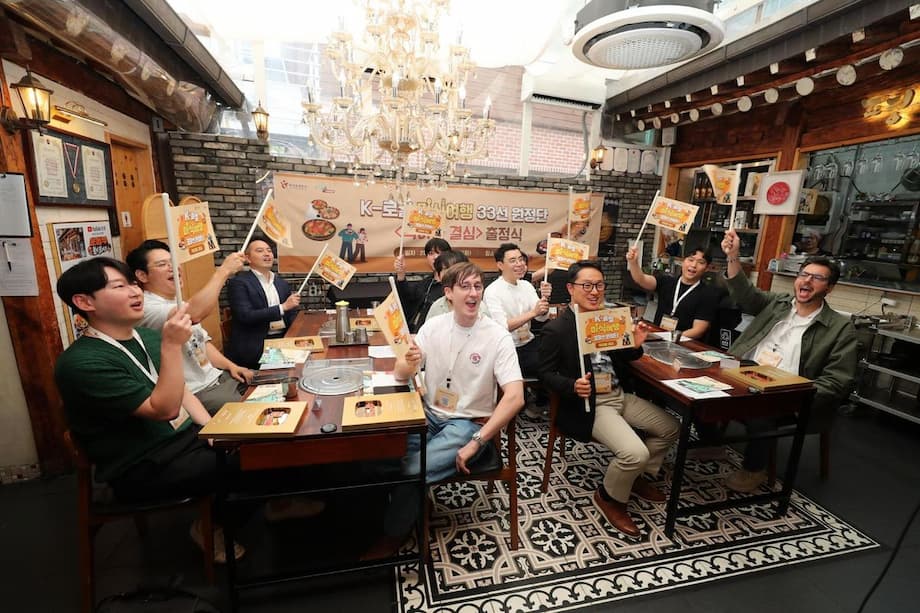A fresh push to put local kitchens on the map
The Korea Tourism Organization has launched K-Local Food Trip: 33 Must Try Destinations, a nationwide campaign designed to showcase regional kitchens, time honored dining rooms, and the ingredients that define Korea’s culinary identity. The initiative aims to position Korea as a top choice for global food travelers by pairing a curated list of authentic eateries with an on the ground content tour that will roll across the country during the peak fall travel season.
- A fresh push to put local kitchens on the map
- Who is on the gourmet road team
- Why food tourism matters now
- Inside the 33 must try destinations
- A day in Andong with chef Fabrizio Ferrari
- How KTO is tying food to travel deals and K culture
- What this means for regional cities and small restaurants
- How to join or follow the campaign
- At a Glance
The campaign opened at Pyongyangok, a more than 100 years old restaurant in Seoul’s Seodaemun District, where a gourmet expedition team was introduced. From October through November, the team will film and share local stories, spotlight seasonal produce, seafood, and specialty dishes, and meet the makers who keep regional traditions alive. Their videos and posts are intended to turn hidden gems into must visit stops for visitors planning trips inspired by Korean culture, film, and music.
KTO’s effort builds on a surge in food focused travel to Korea, with recent surveys showing that roughly 60 percent of visitors cite cuisine or gourmet tours as a primary reason for the trip. To connect with new audiences, the campaign will also link web content to KPop Demon Hunters, using the movie’s global buzz to point viewers toward the country’s real world flavors.
A KTO official described the message behind the new push and said the organization wants to bring both residents and international visitors into the country’s dining heritage.
“Through the project, we hope to share the charm of Korean gastronomy not only with Koreans, but also with travelers worldwide.”
Who is on the gourmet road team
The expedition team brings together chef driven expertise and digital reach. Fabrizio Ferrari, a Michelin starred Italian chef popular with Korean audiences, will join British YouTuber Joshua Kirby and Korean food creator Cookim to lead the storytelling. Each will travel widely, meet local cooks and producers, and publish videos that explain how signature dishes are prepared and why certain regions developed distinct flavors.
Expect scenes from bustling markets, quiet fishing ports, and family run kitchens. The team’s plan includes segments on regional specialties, such as beef ribs in Suwon, dakgalbi in Chuncheon, and tteokgalbi in Gwangju, along with spotlights on traditional liquors that are made with local rice and water. The goal is to show visitors how to order, what to try first, and which customs matter at the table.
Why food tourism matters now
Korean food has become part of a wider cultural wave. Visitors arrive for music, dramas, beauty trends, and esports, then build itineraries around restaurants, street food, and cooking classes. The appeal cuts across age groups, yet tour operators say growth is especially strong among middle aged travelers who value comfort, culture, and a slower look at regional life. Those preferences fit with fall travel patterns, when harvest ingredients arrive and local festivals fill the calendar.
Industry officials point to the importance of regional experiences. Package tours that combine a major city with a smaller county have sold well this year in markets like Japan, helped by social media videos of folk festivals and seasonal food. Agencies are also moving more customers toward culinary themed days in cities known for heritage recipes and markets.
Shinya Chiba, an official at the Japan Association of Travel Agents, said interest is rising among older travelers and framed the opportunity for regional products.
“Many in their 50s and 60s have the time and resources for longer trips, and they prefer cultural experiences in less crowded areas.”
This aligns with KTO’s broader strategy for inbound tourism, which prioritizes immersive programs over quick sightseeing. Travelers increasingly plan their own routes using videos, influencer posts, and official mobile apps, then choose experiences like drama location walks, wellness retreats, hiking, and food trails that feel personal and hands on.
Inside the 33 must try destinations
The list of 33 destinations was compiled by the Ministry of Culture, Sports and Tourism together with KTO. It extends a culinary tourism initiative launched in 2024 and updates it for 2025 with more regional balance and clearer guidance for first time visitors. Each destination highlights a signature dish, the ingredients that make it taste the way it does, and suggested places to try it. The guide is meant to steer travelers to kitchens that have kept traditions intact while welcoming newcomers.
This year’s edition merges with Baeknyeongage, a program that celebrates restaurants and shops with decades of history. The integration produces a new map of time tested venues, giving visitors a reliable way to find kitchens that have served communities for a generation or more.
What is Baeknyeongage
Baeknyeongage, often called the 100 year shop program, recognizes stores and restaurants that have operated for at least 30 years and encourages them to carry that heritage forward. For travelers, the seal signals continuity. It points to places where recipes and techniques have been refined over time, where owners pass down know how, and where regional flavors have remained consistent despite changing trends.
What travelers can expect
Expect a mix of traditional markets, family kitchens that specialize in one dish, and small breweries that pour local rice wines or distilled spirits. The guide pairs each location with seasonal advice and introduces the producers behind signature ingredients. Travelers can learn why certain chilies grow better in specific valleys, how local water shapes the taste of a liquor, and what to order when a menu lists several variants of the same dish.
A day in Andong with chef Fabrizio Ferrari
One of the campaign’s marquee experiences is a one day culinary trip to Andong in North Gyeongsang Province led by chef Ferrari. Up to 22 participants will be selected from travelers who submit reviews of featured destinations through the campaign guidebook, with the outing set to include tastes of Andong jjimdak and Andong soju along with local sightseeing. Applications are open on the KTO website through October 12.
Andong jjimdak is a braised chicken dish known for a balanced soy based sauce, deeply flavored with aromatics and often accented with chili for a gentle heat. The texture comes from slow cooking, glass noodles that absorb the sauce, and careful finishing that leaves the chicken tender and the vegetables intact. It is a dish that shows how sweet, savory, and umami can sit together in Korean cooking without excess spice.
Andong soju is a traditional pot distilled spirit made with steamed rice, nuruk (a fermentation starter), and clean local water. Distillation gives it a rounded aroma and a smooth finish compared with lighter table soju. It is usually served in small cups with hearty food, and it reflects a deeper layer of Korean drinking culture that values craftsmanship and place.
How KTO is tying food to travel deals and K culture
KTO is linking the culinary campaign to practical travel benefits and a wave of fall promotions. The BE LOCAL campaign with NAVER Map gives foreign visitors card payment discounts on dining and experiences in cities like Seoul, Busan, and Gyeongju. It also offers savings on express buses, rental cars, and local tour passes. The BE LOCAL list inside NAVER Map helps travelers discover restaurants that fit the K Local Food Trip 33 theme, including spots for traditional liquors and seasonal specialties.
Benefits are time limited and budget dependent, so availability can change. To help with planning, the 1330 Korea Travel Helpline provides English support. The aim is to lower barriers to visiting smaller cities while keeping the experience easy to navigate on mobile devices. KTO and partners want travelers to move confidently between major hubs and regional towns without worrying about transport or language.
During the same period, a nationwide Travel Month in Fall promotion offers a broad set of discounts and themed products. There are special day trips by train through scenic countryside, lodging deals, and local programs like temple stays, wine foot bath sessions, yacht tours, and hikes. Some products include meals and regional activities at prices designed to encourage exploration outside traditional routes. A limited round trip train package priced at 39,000 won per person is among the headline offers, with departures on selected dates and advance registration.
What this means for regional cities and small restaurants
The culinary push is part of a larger KTO strategy to balance inbound tourism across the map. The plan seeks to raise the profile of provinces such as Jeollanam do and Gyeongsangnam do by packaging food with culture, nature, and sports. Digital marketing and influencer collaborations are central to that plan because travelers increasingly plan trips by watching short videos and reading social posts before they book.
Partnerships with Korean food brands also support the effort to convert curiosity into trips. In one example, KTO and Ottogi agreed to collaborate on Korean food campaigns, content, and events aimed at overseas visitors. Lee Hak ju, who leads KTO’s international tourism division, described the objective and the scale the agency is targeting.
“Through this business agreement, we are looking to create new mediums for foreigners to experience K-food. Leveraging the rising status of K-food abroad, we hope to open a new era of Korean tourism, garnering over 20 million overseas visitors.”
Growth will require practical fixes as well as creative storytelling. Transport connections and language support can still be challenging in smaller towns. KTO is promoting essential apps for transit and sightseeing and backing hotline services to reduce friction. If the campaign succeeds, it can spread visitor spending more evenly, reduce crowding in a few districts of Seoul, and help long running restaurants stay healthy by welcoming new customers.
How to join or follow the campaign
Travelers can browse the K Local Food Trip 33 guidebook, visit featured destinations, and post a review to be eligible for selection for chef Ferrari’s Andong day trip. The application window runs until October 12 and details are available on KTO’s official channels. The expedition team will share travel diaries, kitchen footage, and tasting notes across major platforms through November, so fans can follow the route and build itineraries from the posts.
Visitors coming this fall can stack benefits by checking the BE LOCAL promotions on NAVER Map, using the Gyeongbuk Tour Pass where it fits, and calling 1330 for assistance if plans change. For updates on regional dining spots and limited time discounts, see the BE LOCAL page from KTO and NAVER Map at VisitKorea.
At a Glance
- KTO launched K-Local Food Trip: 33 Must Try Destinations to promote regional cuisine nationwide
- Kickoff took place at Pyongyangok in Seoul, a historic restaurant more than a century old
- Gourmet expedition team features chef Fabrizio Ferrari, YouTuber Joshua Kirby, and creator Cookim
- Travel and content production run from October to November with a focus on local ingredients and heritage dishes
- Special Andong one day trip led by Ferrari will host up to 22 participants chosen from guidebook review submissions
- Applications for the Andong trip are open on the KTO website through October 12
- The 33 destinations were curated by the Ministry of Culture, Sports and Tourism and KTO, expanding a 2024 initiative
- This year’s guide merges with Baeknyeongage to map restaurants with at least 30 years of history
- BE LOCAL with NAVER Map offers dining and travel discounts for foreign visitors through mid December
- Fall travel promotions include discounted train trips, lodging deals, and themed regional experiences through November 30
- Recent surveys show about 60 percent of foreign visitors come to Korea with food as a main motivator
- KTO’s strategy aims to spread inbound travel beyond Seoul and Busan and support small restaurants in regional cities




